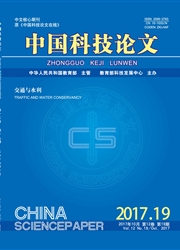

 中文摘要:
中文摘要:
基于斜拉桥模型地震模拟振动台试验和LS-DYNA显式积分有限元模型,提出了相应的构件失效准则和结构倒塌失效准则,对斜拉桥在强震作用下单一构件破坏模式以及多构件破坏耦合作用的倒塌破坏模式进行了分析和探讨。研究表明:考虑单一构件破坏时,支座失效和拉索脱锚是强震作用下斜拉桥的主要破坏模式;考虑多构件破坏耦合作用时,不同地震波的频谱效应对斜拉桥模型的倒塌模式影响较大,卓越周期较长的地震动作用下斜拉桥发生倒塌破坏的危险性较高,且倒塌均是由于边支座脱空、拉索脱锚、主梁下坠,导致主梁端部竖向位移达到倒塌限值而发生;斜拉桥模型在仅考虑单向地震动输入作用下发生倒塌的危险性要明显小于双向和三向地震动输入的情况。
 英文摘要:
英文摘要:
In recent years ,the dynamic disaster of long‐span cable‐stayed bridge under strong earthquake excitations and its pre‐vention have caused wide concerns .In this paper ,,the corresponding components failure criteria and structural collapse failure cri‐teria were proposed based on the shaking table testing of a cable‐stayed bridge model and explicit integration finite element model with LS‐DYNA software .The failure modes of the cable‐stayed bridge model under strong earthquake excitations were also ana‐lyzed ,in which the single component failure mode and multi‐components coupling failure mode were considered .It can be conclu‐ded from the numerical simulations that the bearing failure and cable anchor system failure are the two main failure modes of the cable‐stayed bridge model under strong earthquake excitations in the case of single component failure mode .Considering the case of multi‐components coupling failure mode , the failure modes of cable‐stayed bridge model have significant differences under earthquake waves with different frequency spectral characteristics .The cable‐stayed bridge model was easier to collapse under earthquake waves with long predominant period .The structural collapse were all due to the side bearing separation ,the anchor failure of cables ,and falling of the main girder ,which will cause the vertical displacement at the end of the girder exceeding the limit value of collapse and then result in the collapse .The cable‐stayed bridge model under unidirectional horizontal seismic waves was less prone to collapse than those under bidirectional and three‐dimensional seismic waves .This study can be taken as the ref‐erence for anti‐collapse design of cable stayed bridge under strong earthquake excitations .
 同期刊论文项目
同期刊论文项目
 同项目期刊论文
同项目期刊论文
 期刊信息
期刊信息
